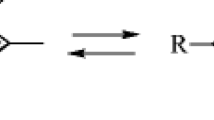Abstract
We have previously described the isolation of the new bacterial species, Ralstonia/Burkholderia sp. strain DSM 6920, which grows with 6-methylnicotinate and regioselectively hydroxylates this substrate in the C2 position by the action of 6-methylnicotinate-2-oxidoreductase to yield 2-hydroxy-6-methylnicotinate (Tinschert et al. 1997). In the present study we show that this enzymatic activity can be used for the preparation of a series of hydroxylated heterocyclic carboxylic acid derivatives. The following products were obtained from the unhydroxylated educts by biotransformation using resting cells: 2-hydroxynicotinic acid, 2-hydroxy-6-methylnicotinic acid, 2-hydroxy-6-chloronicotinic acid, 2-hydroxy-5,6-dichloronicotinic acid, 3-hydroxypyrazine-2-carboxylic acid, 3-hydroxy-5-methylpyrazine-2-carboxylic acid and 3-hydroxy-5-chloropyrazine-2-carboxylic acid. Thus the respective educts were all regioselectively mono-hydroxylated at the carbon atom between the ring-nitrogen and the ring-carbon atom carrying the carboxyl group. In contrast to its relatively broad biotransformation abilities, the strain shows a limited heterocyclic nutritional spectrum. It could grow only with three of the seven transformed educts: 6-methylnicotinate, 2-hydroxy-6-methylnicotinate and 5-methylpyrazine-2-carboxylate. 2-Hydroxynicotinate, 2-hydroxy-6-chloronicotinate, 2-hydroxy-5,6-dichloronicotinate, 3-hydroxypyrazine-2-carboxylate and 3-hydroxy-5-chloropyrazine-2-carboxylate were not degraded by the strain. Therefore, unlike 6-methylnicotinate-2-oxidoreductase, which has a broad substrate spectrum, the second enzyme of the 6-methylnicotinate pathway seems to have a much more limited substrate range. Among 28 aromatic heterocyclic compounds tested as the sole source of carbon and energy, only pyridine-2,5-dicarboxylate was found as a further growth substrate, and this was degraded by a pathway which did not involve 6-methylnicotinate-2-oxidoreductase. To the best of our knowledge the microbial production of 2-hydroxy-6-chloronicotinic acid, 2-hydroxy-5,6-dichloronicotinic acid and 3-hydroxy-5-methylpyrazine-2-carboxylic acid have not been reported before. Strain DSM 6920 is so far the only known strain which allows the microbial production of both these compounds and 3-hydroxypyrazine-2-carboxylic acid and 3-hydroxy-5-chloroypyrazine-2-carboxylic acid.
Similar content being viewed by others
Author information
Authors and Affiliations
Additional information
Received: 18 June 1999 / Received revision: 30 August 1999 / Accepted: 3 September 1999
Rights and permissions
About this article
Cite this article
Tinschert, A., Tschech, A., Heinzmann, K. et al. Novel regioselective hydroxylations of pyridine carboxylic acids at position C2 and pyrazine carboxylic acids at position C3. Appl Microbiol Biotechnol 53, 185–195 (2000). https://doi.org/10.1007/s002530050007
Issue Date:
DOI: https://doi.org/10.1007/s002530050007




